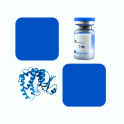
- Remove this product from my favorite's list.
- Add this product to my list of favorites.
Products
Newsletter
 |  |  |  |  |  |

Background
Fibroblast growth factor receptor 1 (FGFR1) is also known as basic fibroblast growth factor receptor 1(BFGFR1), FMS-like tyrosine kinase, CD331, and is a receptor tyrosine kinase whose ligands are specific members of the fibroblast growth factor family. This protein is one of several fibroblast growth factor receptors, which are related proteins that are involved in important processes such as cell division, regulation of cell growth and maturation, formation of blood vessels, wound healing, and embryonic development.The FGFR1 protein spans the cell membrane, so that one end of the protein remains inside the cell and the other end projects from the outer surface of the cell. This positioning allows the FGFR1 protein to interact with specific growth factors outside the cell and to receive signals that help the cell respond to its environment. When growth factors attach to the FGFR1 protein, the receptor triggers a cascade of chemical reactions inside the cell that instruct the cell to undergo certain changes, such as maturing to take on specialized functions. The FGFR1 protein is thought to play an important role in the development of the nervous system. This protein may also help regulate the growth of long bones, such as the large bones in the arms and legs.
Source
Recombinant Human FGF R1, His Tag (FG1-H5223) is expressed from human 293 cells (HEK293). It contains AA Arg 22 - Ile 376 (Accession # P11362-7).
Predicted N-terminus: Arg 22
Molecular Characterization
This protein carries a polyhistidine tag at the C-terminus.
The protein has a calculated MW of 41.2 kDa. The protein migrates as 60-90 kDa under reducing (R) condition (SDS-PAGE) due to glycosylation.
Endotoxin
Less than 1.0 EU per μg by the LAL method.
Purity
>95% as determined by SDS-PAGE.
Bioactivity
Please refer to product data sheet.
Formulation
Lyophilized from 0.22 μm filtered solution in PBS, pH7.4 with trehalose as protectant.
Reconstitution
See Certificate of Analysis for details of reconstitution instruction and specific concentration.
Storage
For long term storage, the product should be stored at lyophilized state at -20°C or lower.
Please avoid repeated freeze-thaw cycles.
This product is stable after storage at:
-20°C to -70°C for 12 months in lyophilized state;
-70°C for 3 months under sterile conditions after reconstitution.
(1) "Treatment with dapagliflozin increases FGF-21 gene expression and reduces triglycerides content in myocardial tissue of genetically obese mice"
Di Vincenzo, Crescenzi, Granzotto et al
J Endocrinol Invest (2024)
(2) "Unraveling the Mechanisms of Sensitivity to Anti-FGF Therapies in Imatinib-Resistant Gastrointestinal Stromal Tumors (GIST) Lacking Secondary KIT Mutations"
Boichuk, Dunaev, Skripova et al
Cancers (Basel) (2023) 15 (22)
(3) "scMultiome analysis identifies embryonic hindbrain progenitors with mixed rhombomere identities"
Kim, O'Rourke, Sagerström
Elife (2023) 12
Showing 1-3 of 146 papers.
FGF-1, 50 µg - 145,00 €
FGF-2, 50 µg - 145,00 €
Recombinant human FGFR4 /CD334 Protein, His tag, 200µg - 468,00 €
Follow us